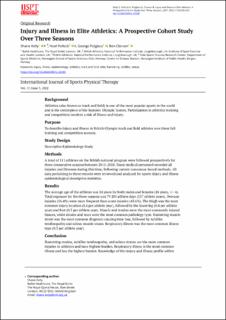| dc.contributor.author | Kelly, Shane | |
| dc.contributor.author | Pollock, Noel | |
| dc.contributor.author | Polglass, George | |
| dc.contributor.author | Clarsen, Benjamin Matthew | |
| dc.date.accessioned | 2022-05-27T13:55:23Z | |
| dc.date.available | 2022-05-27T13:55:23Z | |
| dc.date.created | 2022-04-22T08:36:54Z | |
| dc.date.issued | 2022 | |
| dc.identifier.citation | International Journal of Sports Physical Therapy. 2022, 17(3), Side 420-433. | en_US |
| dc.identifier.issn | 2159-2896 | |
| dc.identifier.uri | https://hdl.handle.net/11250/2996525 | |
| dc.description | This is an open-access article distributed under the terms of the Creative Commons Attribution 4.0 International License (CCBY-NC-4.0). | en_US |
| dc.description.abstract | Background: Athletics (also known as track and field) is one of the most popular sports in the world and is the centrepiece of the Summer Olympic Games. Participation in athletics training and competition involves a risk of illness and injury.
Purpose: To describe injury and illness in British Olympic track and field athletes over three full training and competition seasons.
Study Design: Descriptive Epidemiology Study
Methods: A total of 111 athletes on the British national program were followed prospectively for three consecutive seasons between 2015-2018. Team medical personnel recorded all injuries and illnesses during this time, following current consensus-based methods. All data pertaining to these records were reviewed and analyzed for sports injury and illness epidemiological descriptive statistics.
Results: The average age of the athletes was 24 years for both males and females (24 years, +/- 4). Total exposure for the three seasons was 79 205 athlete days (217 athlete years). Overuse injuries (56.4%) were more frequent than acute injuries (43.6%). The thigh was the most common injury location (0.6 per athlete year), followed by the lower leg (0.4 per athlete year) and foot (0.3 per athlete year). Muscle and tendon were the most commonly injured tissues, while strains and tears were the most common pathology type. Hamstring muscle strain was the most common diagnosis causing time loss, followed by Achilles tendinopathy and soleus muscle strain. Respiratory illness was the most common illness type (0.3 per athlete year).
Conclusion: Hamstring strains, Achilles tendinopathy, and soleus strains are the most common injuries in athletics and have highest burden. Respiratory illness is the most common illness and has the highest burden. Knowledge of this injury and illness profile within athletics could be utilised for the development of targeted prevention measures within the sport at the elite level.
Level of Evidence: 3 | en_US |
| dc.language.iso | eng | en_US |
| dc.subject | achilles | en_US |
| dc.subject | athletics | en_US |
| dc.subject | elite | en_US |
| dc.subject | epidemiology | en_US |
| dc.subject | hamstring | en_US |
| dc.subject | illness | en_US |
| dc.subject | injury | en_US |
| dc.subject | soleus | en_US |
| dc.subject | track and field | en_US |
| dc.title | Injury and illness in elite athletics: A prospective cohort study over three seasons | en_US |
| dc.type | Peer reviewed | en_US |
| dc.type | Journal article | en_US |
| dc.description.version | publishedVersion | en_US |
| dc.rights.holder | © Author(s) (or their employer(s)) 2021 | en_US |
| dc.source.pagenumber | 420-433 | en_US |
| dc.source.volume | 17 | en_US |
| dc.source.journal | International Journal of Sports Physical Therapy | en_US |
| dc.source.issue | 3 | en_US |
| dc.identifier.doi | 10.26603/001c.32589 | |
| dc.identifier.cristin | 2018295 | |
| dc.description.localcode | Institutt for idrettsmedisinske fag / Department of Sports Medicine | en_US |
| cristin.ispublished | true | |
| cristin.fulltext | original | |
| cristin.qualitycode | 1 | |
